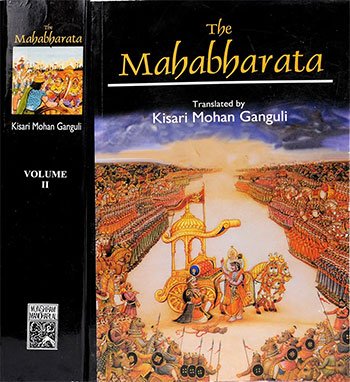Section CXI - Battle of Kurukshetra: Arjuna vs Dussasana in fierce combat
Book index: Mahabharata (English)
This page contains a summary of the Mahabharata Section CXI including examples of moral lessons in daily life. The Maha-Bharata is one of the largest epics ever written containing roughly 100,000 Sanskrit verses. It deals with the legendary history of ancient India and contains a large number of interwoven tales.
Short summary of the chapter:
In the midst of the battle, Arjuna, inspired by the prowess of Bhishma, urges Sikhandin to attack the grandsire without fear, promising to support him with his own sharp arrows. Encouraged by Arjuna's words, several other warriors from the Pandava army also join in the assault on Bhishma, including Dhrishtadyumna, Abhimanyu, Nakula, Sahadeva, Yudhishthira, and others. On the other side, Duryodhana's warriors, such as Citrasena, Kritavarman, Vikarna, and others, lead the defense against the advancing Pandava forces.
As the battle intensifies, various key warriors from both sides engage in fierce combat, with Bhishma being the primary target for the Pandavas. Dhrishtadyumna, in particular, leads the charge against Bhishma, while Arjuna confronts Dussasana in a notable duel where both warriors exchange powerful blows. Despite Dussasana's efforts to defend Bhishma, Arjuna manages to pierce him with a barrage of arrows, creating a striking visual spectacle on the battlefield.
The confrontation between Arjuna and Dussasana escalates as both warriors unleash their full might, exchanging devastating blows and inflicting significant damage to each other's chariots and armor. Arjuna, fueled by rage and determination, successfully disarms Dussasana and continues to rain down arrows upon him, demonstrating his unparalleled archery skills and unwavering resolve. Dussasana, despite putting up a valiant fight, is ultimately overwhelmed by Arjuna's relentless assault, showcasing the latter's superiority in combat.
The encounter between Arjuna and Dussasana serves as a pivotal moment in the battle, highlighting the fierce rivalry and skillful tactics employed by both warriors. Arjuna's strategic prowess and combat proficiency are on full display as he outmaneuvers and outmatches Dussasana in a series of intense exchanges, eventually gaining the upper hand in their duel. As the conflict between the two warriors reaches its climax, the outcome of their clash becomes symbolic of the larger struggle for supremacy and victory in the epic Kurukshetra war.
Full English translation:
This page is merely a summary which is automatically generated. If you are looking for authentic sources such as the Sanskrit text or the Full English translation of Mahabharata Section CXI - Battle of Kurukshetra: Arjuna vs Dussasana in fierce combat, have a look at the following articles:
Section CXI, online text
English translation by Kisari Mohan Ganguli.
Read this and other chapters online.
Mahabharata (English Summary)
by Kisari Mohan Ganguli | ISBN-10: 8121505933
Buy the latest edition:
FAQ of Mahabharata, Section CXI:
What was Arjuna's plan in the battle against Bhishma?
Arjuna planned to have Sikhandin attack Bhishma while he distracted him.
How did Duryodhana's warriors respond to the Pandavas' attack on Bhishma?
They bravely resisted the Pandavas and protected Bhishma.
How did the battle between Arjuna and Dussasana unfold?
Arjuna and Dussasana engaged in fierce combat, exchanging powerful attacks.
Daily life: Battle of Kurukshetra: Arjuna vs Dussasana in fierce combat:
The narrative revolves around a fierce battle, showcasing determination, courage, and support among allies, which are essential qualities not just in warfare but in everyday challenges. In our daily lives, we can draw inspiration from Arjuna's encouragement to his allies to face fears head-on, embodying the importance of supportive relationships where we uplift and back each other in times of adversity. Similarly, just like the warriors rallied around a common goal, we, too, can accomplish greater feats when we unite with others towards shared objectives, be it in a workplace setting, within families, or in social circles.
Facing obstacles with the same resilience and strategic thinking as the characters can also guide us to overcome personal battles. The notion of facing fears, as Sikhandin was encouraged to do, teaches us the power of confronting our challenges directly, rather than avoiding them. Moreover, the story highlights the significance of perseverance and focus; despite facing formidable adversaries, the Pandavas' unwavering determination led them to push through barriers, a lesson in staying the course despite difficulties.
In essence, the episodes from the battle encourage embracing bravery, forging strong alliances, and staying determined in the face of challenges, all of which are vital for personal growth and overcoming obstacles in daily life.
